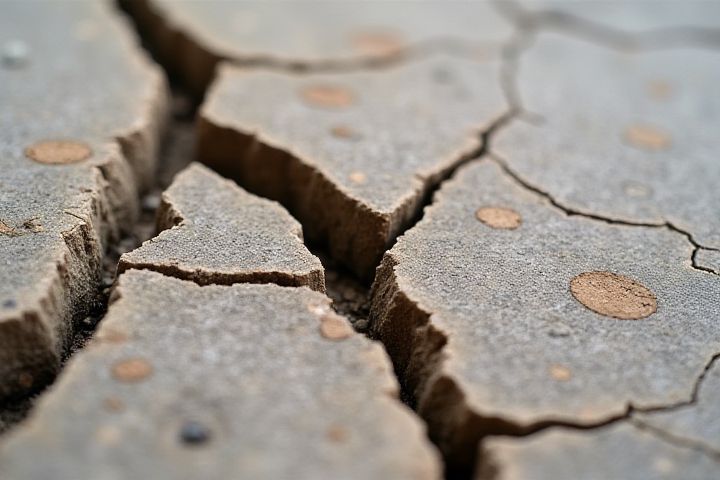
House foundation cracks can result from various factors, including soil movement, poor drainage, and temperature fluctuations. When the soil around the foundation expands or contracts due to moisture changes, it exerts pressure on the foundation, leading to cracks. Inadequate drainage systems can cause water accumulation around the foundation, weakening the soil and causing settling issues. Seasonal temperature changes can lead to the contraction and expansion of building materials, contributing to the formation of cracks. Identifying the cause early is essential to prevent further damage and ensure the structural integrity of your home.
What Causes House Foundation Cracks
Soil movement
Soil movement is a primary cause of house foundation cracks, often resulting from changes in moisture content, temperature fluctuations, or expansive soil conditions. When the soil beneath a foundation absorbs water during heavy rainfall or irrigation, it can swell, exerting upward pressure on the foundation. Conversely, in dry conditions, soil can shrink, leading to settlement and downward pressure that may create visible cracks in the foundation. Maintaining consistent moisture levels through proper drainage and landscaping practices can help mitigate these issues and protect your foundation's integrity.
Poor drainage
Poor drainage is a leading cause of house foundation cracks, as it allows excess water to accumulate around the foundation. This water can seep into soil, causing it to expand and contract, ultimately leading to pressure on the foundation. Over time, this pressure may result in fissures and cracks, which can measure anywhere from hairline widths to several inches. Maintaining proper grading and ensuring gutters and downspouts direct water away from the foundation are crucial steps in preventing these costly structural issues.
Tree roots
Tree roots can exert considerable pressure on a home's foundation, often leading to significant cracks. As roots grow, they can encroach upon the soil beneath and around your foundation, displacing it and causing instability. For instance, a mature oak tree with roots extending 40 feet can pull moisture from the soil, leading to shrinkage and subsequent settling of the foundation, which is especially common in clay-rich soils. Maintaining a distance of at least 10 to 15 feet between large trees and your foundation can mitigate the risk of these damaging effects.
Temperature fluctuations
Temperature fluctuations are a primary cause of house foundation cracks, as they lead to the expansion and contraction of soil and building materials. For instance, during high summer temperatures, clay soil can shrink significantly, while cold winter temperatures can cause it to swell as moisture is absorbed. This constant movement can create pressure against the foundation, resulting in cracks that may widen over time. Homeowners should monitor these changes and consider preventive measures, such as proper drainage and insulation, to minimize damage to their foundation.
Poor construction
Poor construction practices significantly contribute to the development of house foundation cracks. For instance, inadequate soil compaction before pouring concrete can lead to uneven settling, resulting in stress on the foundation. Additionally, using substandard materials, such as low-grade concrete, compromises the structural integrity, making it more susceptible to cracking. Improper drainage systems can also exacerbate moisture-related issues, leading to further foundation damage over time.
Heavy loads
Heavy loads, such as large vehicles parked near the foundation or significant weight from upper floors, can exert excessive pressure on the base of a house, leading to foundation cracks. When the soil under the foundation is not designed to support these loads, it can become compacted, shift, or even erode. This movement creates tension in the foundation materials, resulting in visible cracks, often measuring from hairline to several inches in width. Regularly assessing your property for signs of uneven settling or shifting can help mitigate long-term structural damage.
Earthquakes
House foundation cracks can occur due to the ground shaking during earthquakes, resulting in soil liquefaction or displacement. Seismic activity can exert significant forces on a structure, leading to uneven settling or shifting of the foundation. The intensity of the earthquake, measured on the Richter scale, directly correlates with the potential for damage, with quakes above 5.0 posing a substantial risk. If your home is in a seismically active zone, regular assessments and retrofitting can help mitigate these risks and protect your foundation.
Water leakage
Water leakage significantly contributes to house foundation cracks, creating pressure against the structure. When excessive moisture accumulates in the soil surrounding the foundation, it leads to soil expansion and contraction, which can exert force on the foundation walls. Over time, this movement weakens the integrity of the foundation, often resulting in visible cracks. It's essential to address any drainage issues or plumbing leaks promptly, as even a small leak can escalate into a major problem, compromising your home's stability.
Shrinking concrete
Shrinking concrete is a significant cause of house foundation cracks, often resulting from the curing process where moisture evaporates. Typically, this shrinkage can lead to horizontal or vertical cracks appearing within the first few months after the concrete is poured, particularly in large slabs. Factors such as temperature fluctuations and drying conditions can exacerbate the severity, with cracks possibly widening if the underlying soil settles. To mitigate the risk of shrinking concrete cracks, maintaining proper moisture levels during curing and employing control joints can be effective strategies for homeowners.
Seismic activity
Seismic activity, including earthquakes, significantly impacts house foundations, often leading to cracks that compromise structural integrity. Ground shaking during an earthquake generates forces that can cause soil displacement, resulting in uneven settling or heaving of the foundation. The intensity of the seismic event can determine the extent of damage; for instance, a quake with a magnitude above 5.0 is likely to produce more severe cracks. Regular structural assessments in earthquake-prone areas can help identify vulnerabilities and mitigate the risks associated with seismic-related foundation damage.
